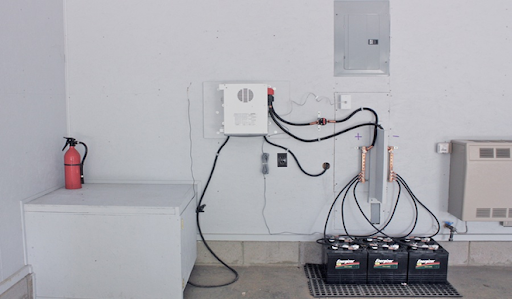A solar panel generates electricity from sunlight, and a solar inverter converts that energy into electricity that can be used in your home or office. And since the appliances in your home run on AC, not DC, which is why the solar inverter must change the DC output that is collected by your solar panels.
A solar battery is used to store energy produced by solar panels into usable electricity to power your home or business. So, Whenever there is light off you can switch your solar inverter to power your home or business.

Your solar panels, also known as photovoltaic (PV)cells because they are constructed of semiconductor layers of crystalline silicon or gallium arsenide, receive illumination from the sun.
These layers, which also are joined by a junction, combine positive and negative layers. The semiconductor layers capture sunlight and deliver the energy to the photovoltaic cell. Direct current is created when this energy knocks electrons loose and causes them to travel between both the positive and negative layers (DC). When this energy is created, it is either routed immediately to an inverter or stored in a battery for later use (this depends on the type of system you have).
Although your home needs AC, the energy is transmitted to the converter in DC format.
The energy is taken in by the inverter and passed via a transformer, which produces an AC output. By making the transformer behave like AC, the inverter essentially “trickles” the transformer into believing that the DC is truly AC. To do this, it passes the DC through two or more transistors that rapidly turn on and off and feed two different sides of the transformer.
Make sure to get in touch with Solarity Plus (by Vanpeux Limited) battery storage installers if you want to combine your solar panels with storage to obtain the best installation at the lowest cost.
Can solar standing fans be used in conjunction with other power sources?
Yes, solar standing fans can be used in conjunction with other power sources to provide flexibility in usage and ensure continuous operation, especially during periods of low sunlight or at night. Here are some ways solar standing fans can be combined with other power sources: Battery Backup: Many solar-powered fans
Are solar standing fans noisy?
Solar standing fans are generally designed to operate quietly, especially compared to some traditional electric fans that can produce noticeable noise when running. The noise level of a solar standing fan can vary depending on factors such as the quality of construction, motor design, and fan blade design. However, manufacturers
What size of solar panel is needed for a solar standing fan?
The size of the solar panel needed for a solar standing fan depends on several factors, including the power consumption of the fan, the desired charging time, and the efficiency of the solar panels. Here are some considerations to help determine the appropriate size of the solar panel: Power Consumption
What maintenance is required for a solar standing fan?
Solar standing fans typically require minimal maintenance. Regular cleaning of the solar panels to remove dust and debris can help optimize charging efficiency. Additionally, checking the fan blades for any obstructions or signs of wear is recommended. Maintaining a solar standing fan is generally straightforward and requires minimal effort. Here
Can solar standing fans be used indoors?
Yes, solar standing fans can be used indoors, provided they have access to sufficient sunlight for charging. However, there are a few considerations to keep in mind when using solar standing fans indoors: Buy from paystack Buy Direct from us Sunlight Exposure: Since solar standing fans rely on sunlight to
How long does it take to charge a solar standing fan?
Charging times can vary depending on factors such as sunlight intensity and the capacity of the solar panels and batteries. Generally, it may take a few hours of exposure to sunlight to fully charge a solar standing fan. The time it takes to charge a solar standing fan can vary
